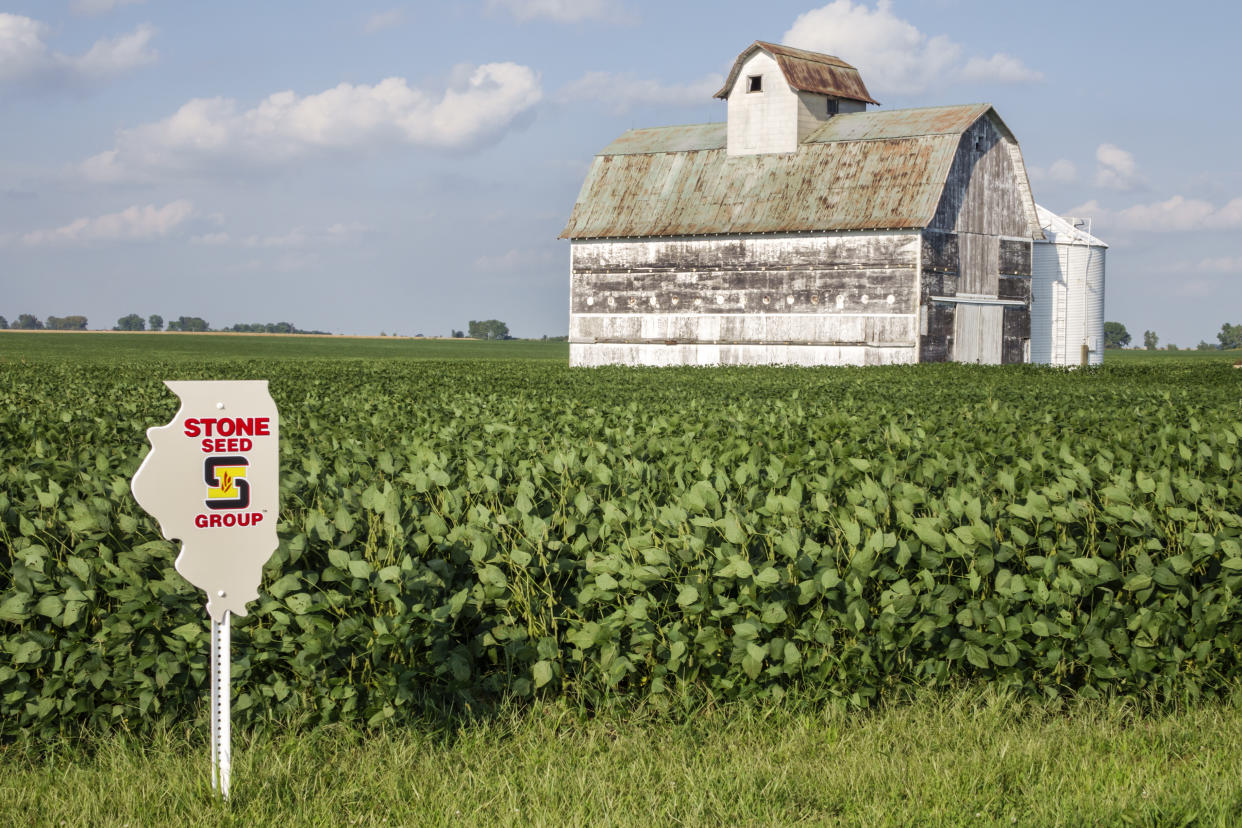American farmers say China can't meet its future demand for soybeans without the US

U.S. soy farmers caught up in trade disputes between the U.S. and China that escalated over the weekend say they’re weathering decreased business from the globe’s largest soy importer. But these farmers remain confident China’s tough stance on trade will prove unsustainable.
Brazil, the world’s largest soy exporter, can’t independently produce enough soy for China’s swelling middle class, Darin Johnson, a soy farmer in Southern Minnesota, told Yahoo Finance. Over the past year, China has turned to soy producers in Brazil and Argentina, countries expected to increase exports during the next marketing year.
“There just isn't enough soy in the world to provide all of their needs,” said Johnson, who’s also secretary of the Minnesota Soybean Growers Association.
‘They can’t ... eliminate demand for U.S. soybeans’
This week, reports emerged that China had halted agriculture purchases by state-owned enterprises, and that privately run Chinese companies that had been granted waivers to buy soybeans had stopped doing so because of trade war fears. But this situation is untenable, according to representatives from various agriculture trade groups in the U.S.
“The fact of the matter is that the U.S. is the world's largest soybean producer, and the second largest exporter, after Brazil, and the world needs U.S. agricultural products,” said Owen Wagner, CEO of the North Carolina Soybean Association.
“What China has been able to accomplish, by putting tariffs on U.S. soybeans, is basically to put our soybeans on sale relative to Brazil,” he said. “But they can't effectively eliminate demand for U.S. soybeans.”
There’s another reason China’s ability to further retaliate against American soy producers is weakening, according to Wagner.
“They've done as close to as much damage as they can do within the context of this year,” Wagner told Yahoo Finance, explaining that China’s imports of American soy, down 75% to 80% from peak levels set in 2016-2017, and down as much as 98% in 2018, are close to bottoming out. China’s decreased reliance on American soy, he said, has led to a “reshuffling” of global trade flows that have seen U.S. soy farmers seeking alternative markets.
“What we've seen is the U.S. has been really successful in growing its exports to Europe,” he said. “They've been close to 10 million tons over the past year, and that's a level that hasn't been seen since the mid-1990s.” U.S. soybean exports to Mexico have also increased over the past two years, he said.
Swine fever means China needs less soy — for now
A major factor currently giving China flexibility to aggressively pull back on U.S. soy imports, Wagner said, is the country’s depressed need for hog feed, which is produced using soy meal. The outbreak of African Swine Fever (ASF), estimated to reduce China’s pig herds by 50% by the end of 2019, means that temporarily, significantly less soy meal is required to fuel its pork industry.

“China has the largest pig herd in all the world,” Austin Rincker, a Central Illinois soy farmer and member of the Illinois Soybean Association board, told Yahoo Finance, “but it’s a little bit of a double-edged sword with swine fever.”
Rincker said the continuing outbreak makes future global soy demand uncertain, creating a wait-and-see approach for American farmers.
“I don’t know if anybody’s really wrapped their head around truly what that number is, and I bet even China doesn't really have a firm grasp on what those hog numbers really look like, so that's really going to be a major player on what their what their true demand is,” he said.
Economic research published by the USDA in May forecasts FY2019 soybean exports down $1.5 billion to $17.0 billion, “driven by lower demand due to African Swine Fever, weak prices, and continuing trade tensions with China.”
Johnson described swine fever’s impact on the industry as potentially “huge.”
“If China butchered 10% of [the hogs] they raise in China that would be equivalent to all of what we raise in the entire U.S.,” he said. “That’s why trade with China is so important.”
Jeffrey Landsberg, Managing Director for Commodore Research & Consultancy said depressed export levels show U.S. soy farmers have not been able to successfully find alternative markets.
“Compared to the same period last year, this marks a year-on-year contraction of 11.5 million tons, which in percentage terms marks a year-on-year contraction of 22%,” Landsberg said.

Johnson said the soy industry is also working hard to find new uses for the crop that include biodiesel fuel, tires, and road overlays. Increased demand for new products, he hopes, will lessen U.S. producers’ reliance on China.
Regardless of future innovation and eventual safe havens, soy producers want to see trade deals materialize, both in China and globally.
“Obviously, every year that this continues going into the future is bad for the industry and our growers would certainly prefer to be selling their beans in the open market, rather than receiving the Market Facilitation Program [subsidy] payments, which they're incredibly grateful for,” Wagner said.
“We need a trade agreement,” Johnson said, adding that he didn’t view the Trump administration as having made any significant steps in reaching agreements with China or revising the North American Free Trade Agreement under the United States-Mexico-Canada-Agreement. “Unfortunately the American farmer is bearing the weight of this. We know the trade agreements we had with China, with Mexico, we know they’re not perfect, but we need to come to some middle ground sooner than later.”
(This story was updated from a previously published version to include UDSA data on year-over-year soybean exports.)
Alexis Keenan is a New York-based reporter for Yahoo Finance and former litigation attorney. Follow Alexis on Twitter @alexiskweed.
Follow Yahoo Finance on Twitter, Facebook, Instagram, Flipboard, SmartNews, LinkedIn,YouTube, and reddit.

